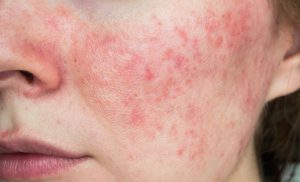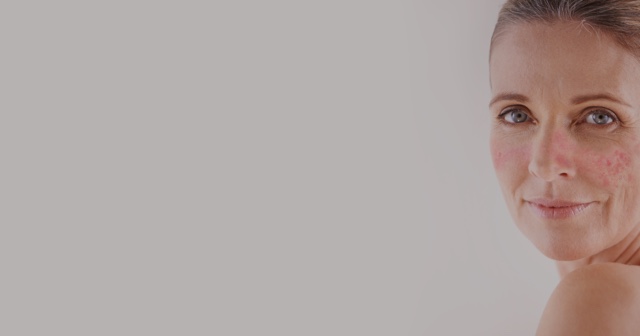What Is Rosacea?
Rosacea is a chronic skin condition that typically affects the face and sometimes the eyes. It’s common to mistake this inflammatory skin problem as acne, an allergic reaction, or eczema because of the redness and acne-like bumps it causes on the skin.
What Does Rosacea Skin Look Like?
Rosacea causes your face and neck to blush or flush more easily. Many sufferers of this skin condition also have small, red, pus-filled bumps, especially on the cheeks, nose, and forehead. Other symptoms of rosacea skin include:
- Persistent skin redness
- Facial swelling
- Dry and flaky skin
- Visible broken blood vessels
- Sensitive skin
- Enlarged nose
- Red, irritated eyes
Causes of Rosacea

- Family history of the skin disease
- An overactive immune system
- Having the intestinal bacteria Helicobacter pylori
- A skin mite called Demodex
- The presence of a protein that normally protects the skin from infection, called cathelicidin
If you already have this skin condition, be aware of these triggers, which can make your symptoms worse:
- Spicy foods
- Chocolate
- Alcohol
- Coffee or tea
- Skincare products containing perfume
- Sunlight
- Heat
- Stress
These risk factors also make you more likely to develop this skin disease:
- Having fair skin
- Being between 30–50 years old
- Scandinavian or Celtic ancestry
- Current or former acne sufferers
Are There Different Rosacea Types??
There are four Rosacea types. Let’s take a closer look at each:
Erythematotelangiectatic: With this type of rosacea, you’ll see tiny broken blood vessels on your skin. You’ll notice flushing and redness in the center of your face, and your skin may feel rough, scaly, and dry. Your skin may also sting, burn, and appear swollen.
Papulopustular: This subtype primarily affects middle-aged women. If you have this type, you’ll have oily skin with acne-like bumps that may be filled with pus. Your skin may be very sensitive and burn or sting. Raised patches of skin called plaques may also appear, along with visibly broken blood vessels.
Phymatous: The phymatous type is very rare. When it does occur, you’ll typically have the symptoms of another subtype first. Your skin may have a bumpy texture, and it may start to thicken around your nose, forehead, chin, cheeks, and ears. Your skin will appear oily with large pores. Visibly broken blood vessels will also develop on your skin.
Ocular: This type affects your eyes, causing them to appear watery and bloodshot. Your eyes may feel gritty, creating a feeling like there’s sand in them. They can sting, itch, burn, and feel very dry. Your eyes will be sensitive to the light, and you may not see as well as you did previously. You’re likely to experience blurry vision, and you might have a cyst on your eyelid, along with visibly broken blood vessels.
What Are Treatment Options For Rosacea?
There isn’t a cure for this skin condition, but there are rosacea treatment options that can help you successfully manage your symptoms and ease your discomfort. Your Premier dermatologist will work with you to design a treatment plan to address the specific type you have, which may include topical medications, oral antibiotics, light therapy, laser therapy, dermabrasion, or eye drops.
Prescription skin creams can reduce redness, inflammation, and acne-like breakouts. Oral antibiotics can ease swelling, reduce redness, and improve acne-like bumps. According to the AAD, most people notice a significant reduction in acne-like breakouts after taking oral antibiotics for one month.
Light therapy, such as photodynamic therapy, may also be a treatment option for some patients. This treatment option can also treat acne-like bumps and redness, but it’s not effective for everyone. Dermabrasion is another cosmetic treatment that can improve the appearance of thickened skin.
If you have the type of rosacea that affects your eyes, your dermatologist can recommend eye drops, and some patients may benefit from an antibiotic. Applying a warm compress to the eyes throughout the day can also be helpful.
Understanding what triggers your symptoms and following a skincare routine are also important aspects of rosacea treatment. Keeping a journal of the foods that you eat can help you identify potential triggers that make your symptoms worse. Wearing sunscreen and avoiding harsh products that irritate your skin can also prevent flare-ups.
With a customized treatment plan, our knowledgeable Premier dermatologists can help to improve the appearance of your skin and manage your symptoms.
Treatment options may vary at each location.
Please confirm your desired treatment is offered at your preferred location when scheduling.


